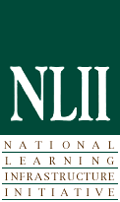

Deeper Learning
Teaching
Practices
Technology
Uses
Learning
Activities
Mapping the Learning Space:
Design Implications
Instructional design and how to effectively teach within one's discipline is never taught in the standard PhD curriculum.
Most higher education faculty do teach but few formally learned how. We model how we were taught and
hope for the best, with little administrative incentive to change.
Knowledge of methods to relate specified events of instruction to learning
processes and learning outcomes is seldom the basis for evaluation of faculty
performance. Effective teaching is new territory for faculty interested in best
practices in teaching and learning, and is especially complex in the new world of eLearning.
We
do know from twenty years of research that there are clear,
causal relationships between procedures used in course modules and their
learning outcomes. We also know that the characteristics present in engaged and meaningful learning are the same, regardless of delivery. Delivery alone delivers no significant difference in outcomes. Exploring affordances of delivery options is where the heart of interesting research now rests. Those interested in exploring the many
definitions and theories related to meaningful teaching and learning when delivered online might start at the
Illinois Online Network portal page, but most
faculty want more practical access to best practices for reaching educational
learning outcomes. How do we design the course experience so that our students
learn and retain what we intended them to learn? What practices ensure better
outcomes?
How do we know that our students know what we intended for them to kow?
Course events must be designed with learning outcomes in mind. This is the core of instructional design. Course modules should take into consideration diverse ways of learning (visual, representational, auditory, kinesthetic) and use diverse methods of reaching varied learners. Modules should be conceived for social, kinesthetic and reflective thinkers. Good instruction is designed for the learner and incorporates assessment of their outcomes.
The traditional lecture is seldom an effective way of reaching diverse learners, especailly a new generation that is increasingly non-auditory. Neither are sophisticated technology and 'flashy' sites necessarily better modules for learning. It is not the complexity of the tool or the application of any particular theory or model, but intended usage that makes effective course design. Constructivists, behaviorists and cognitivists, if forced to speak the same language, would agree that learning outcomes should guide design.
Students learn when they are engaged, active and required to make sense (in
their own words, in their own way) of what they learn. We understand
material only when we make it our own. There are endless ways to help students
understand course content and to "do", instead of hear or see. This is the
meaning of 'active learning'. Technology, by its very essence, allows "doing".
Place a computer in a student's hands and give them the tools to create their
own learning. The role of technology has changed many aspects of higher
education, but none more significantly than "the classroom". Internet access has
made learning accessible all the time, with greater student choice in approaches
to learning. Retooling instructional design choices for the virtual classroom is
a significant focus in design implications for higher education learning. Those
interested in exploring design issues related to online learning (in
traditional, distant and hybrid classes) might start at the Michigan State's excellent online teaching
site or the University of Illinois
Online Learning resources page.